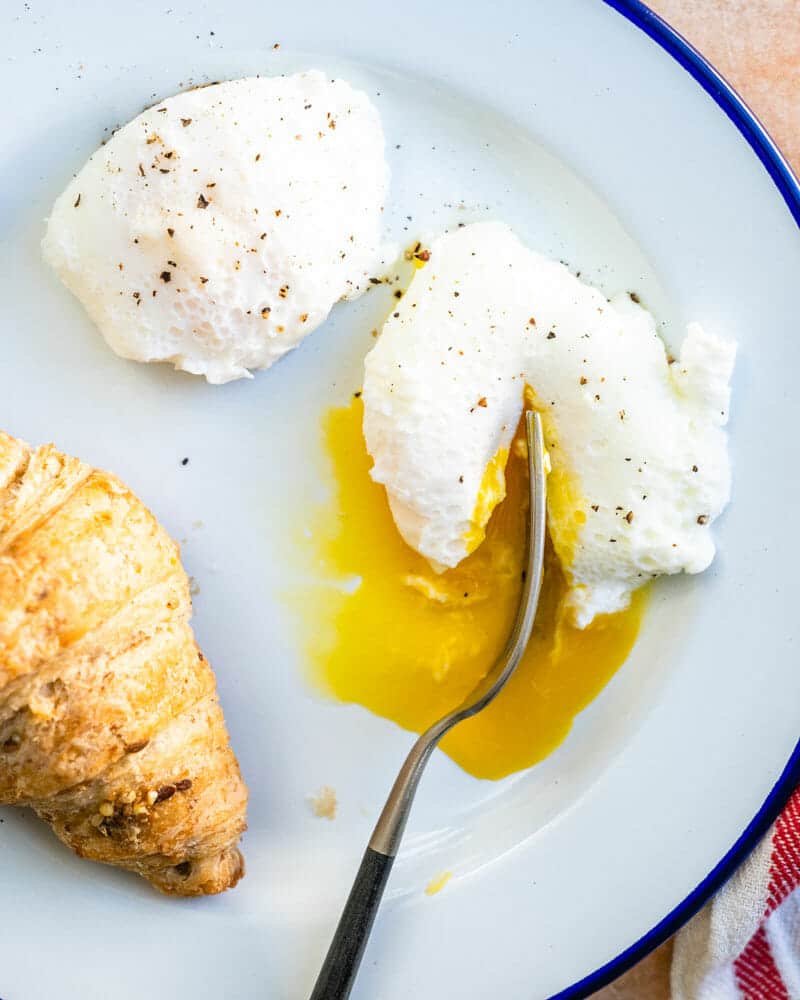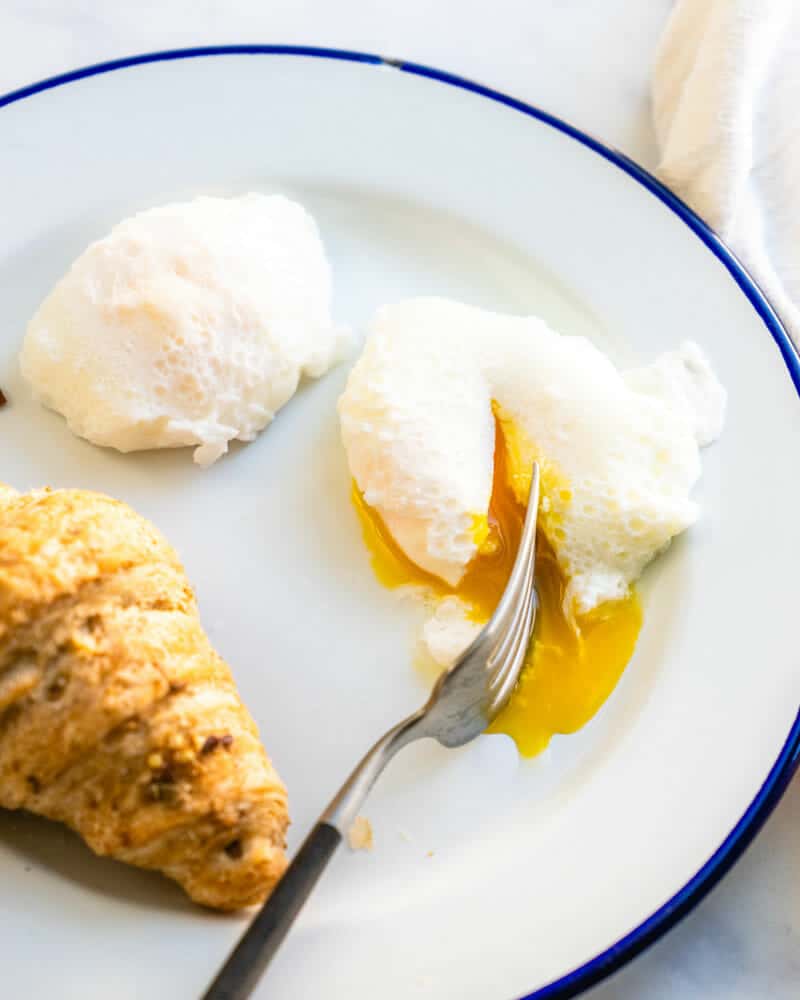Here’s how to poach an egg…perfectly! Here are all the secrets to getting firm whites and a runny yolk with no effort at all.

Looking for those elusive poached eggs? We’ve got you. This French technique for boiling an egg can result in the most silky, runny egg and perfectly firm whites. But it’s also easy to screw up! You can easily end up with a pile of messy whites, or a pale yellow overcooked yolk. How to poach an egg perfectly? Well, we’ve got a few tips that will help it work every time. Here’s what to know!
The best poached eggs recipe? Use fresh eggs.
Here’s the most important thing about making a poached eggs recipe. Start with fresh eggs! This technique works best with eggs that you just brought home from the store, or have had just a few days. Why is this important?
- The whites spread too much with old eggs. When the egg hits the water, the whites spread. When you use older eggs, the white goes wild and spreads around the entire pan.
- With fresh eggs, the whites form together better. This makes a nicer shape. There are a few other tricks people use to try to get the eggs to shape well, but we’ve found the egg age has the most bearing on this.

How to poach an egg
How to poach an egg? Here’s our master method for how to make poached eggs that look good and taste delicious:
- Bring water to just below a simmer with 1 splash white vinegar. Adding vinegar to the water helps the egg whites to firm up even faster when they hit the water. They’ll still spread, but this is a good insurance method.
- Heat the water to 190 degrees Fahrenheit. Contrary to what you might think, don’t bring the water to a boil! You want it just below a simmer. For the best results, use a food thermometer to measure the temperature.
- Crack the eggs into a bowl first. Then slide the eggs into the water. This way you don’t have to worry about shells getting into the water, and you can add it gently. You’ll notice that the egg whites do spread: you can use a spoon to push them closer to the yolk if you’d like.
- Cook 4 minutes, until the whites are cooked and the yolk is still runny. Set a timer and wait, then pop them out with a slotted spoon.
Other notes on method
There are lots of other tricks that we’ve tried to help the egg whites solidify and make a firm, circular shape. Here are a few notes on what we’ve learned:
- Some people say to stir the water to make a spinning vortex. Using this method, the vortex is support to swirl the whites to make them form a more cohesive shape. We’ve tried it both ways and didn’t see a dramatic difference.
- Another method is to place the eggs in a fine mesh strainer. This apparently helps to strain out some of the very fine egg whites, making the shape more cohesive. We tried this and it didn’t work: in fact, it strained out so much of the white that there wasn’t much left. We don’t recommend this method!

Another way to make poached eggs
My parents made poached eggs when I was growing up using an entirely different method: an egg poacher! Here are the pros and cons to using an egg poacher:
- An egg poacher makes the process easier and less messy. This special pan has non-stick cups that you can slide your eggs into. It’s much easier and it makes much less mess in the water.
- The only con? The shape is defined and not organic. We love the organic shape of an egg that’s cooked in water. The egg cups make a defined shape that’s not quite as pretty to look at. But they both taste great!
Make it a meal: how to serve poached eggs!
The great thing about poached eggs are that you can serve them for any meal. Whether it’s breakfast, brunch, lunch or dinner, anything is better with an egg on top! Here are a few serving ideas:
- Add toast for a simple meal
- Serve with roasted asparagus
- Add potatoes like hash browns, sweet potato hash browns or pan fried potatoes
- Use it to top polenta with sauteed greens
- Place it on top of avocado toast
- Add it to savory oatmeal for an elegant breakfast
- Place it on a rice bowl or grain bowl for added protein
How to do serve your poached eggs? Let us know in the comments below.

More ways to cook eggs
Want to cook eggs all the ways? Here are a few more basic methods for how to cook eggs:
- Hard boiled eggs, steamed hard boiled eggs or soft boiled eggs
- How to fry an egg: Sunny side up, Over easy, Over medium, or Over hard
- Omelette
- Scrambled eggs or fluffy eggs
PS Did you know you can freeze eggs and scramble them later? Here’s a weird yet wonderful kitchen tip.
This perfect poached eggs recipe is…
Vegetarian, dairy-free, and gluten-free.
Print
Perfect Poached Eggs
- Prep Time: 3 minutes
- Cook Time: 4 minutes
- Total Time: 7 minutes
- Yield: 4 eggs 1x
Description
Here’s how to poach an egg…perfectly! Here are all the secrets to getting firm whites and a runny yolk with no effort at all.
Ingredients
- 4 fresh eggs
- 1 splash white vinegar
- Kosher salt
- Equipment: small bowl, large skillet, slotted spoon, tea towel
Instructions
- Fill a large skillet with 1 ½ inches of water. Add a pinch of salt and a splash of vinegar. Heat over medium high heat until bubbles start to regularly rise off the bottom, just below a simmer (about 190 degrees Fahrenheit). Be careful to maintain the temperature throughout the cooking process and ensure the water does not boil.
- Crack each egg into a small bowl, then carefully slide each egg into the water. Make sure to give plenty of space between each egg. The egg whites will spread out a bit as they hit the water, then soon start to form up. (You can use a spoon to make them stay next to the yolk: once they’re cooked they’ll form together better.)
- Allow the eggs to cook for 4 minutes, until the whites set. Then turn off the heat. Remove the eggs with a fine mesh sieve or slotted spoon, then place them on a plate lined with a paper towel or clean dish towel to allow the poaching water to drain. If desired, trim the edges before serving.
- Category: Breakfast
- Method: Stovetop
- Cuisine: French
- Diet: Vegetarian
Keywords: Poached eggs, How to make poached eggs, How to poach an egg, Poached egg recipe




I never thought to store them shelled, I’ve always shelled them immediately and then stored the eggs in a tupperware with a paper towel under them in the fridge. They keep about a week if not eaten. Cooks Illustrated suggests putting them in a tupperware of water and ice for about 10 mins after steaming, then pour half the water out and put the lid on the tupperware and shake it vigorously. I was shocked to find all the eggs completely shelled when I opened it again!
★★★★★
Although eggs are one of the foods cooked, the taste of cooking must be good. Cooking the perfect pose is not an easy task. Tried looking at your recipe. Although not successful the first time I succeeded the second time. The taste of cooking has made it yummy.
★★★★★